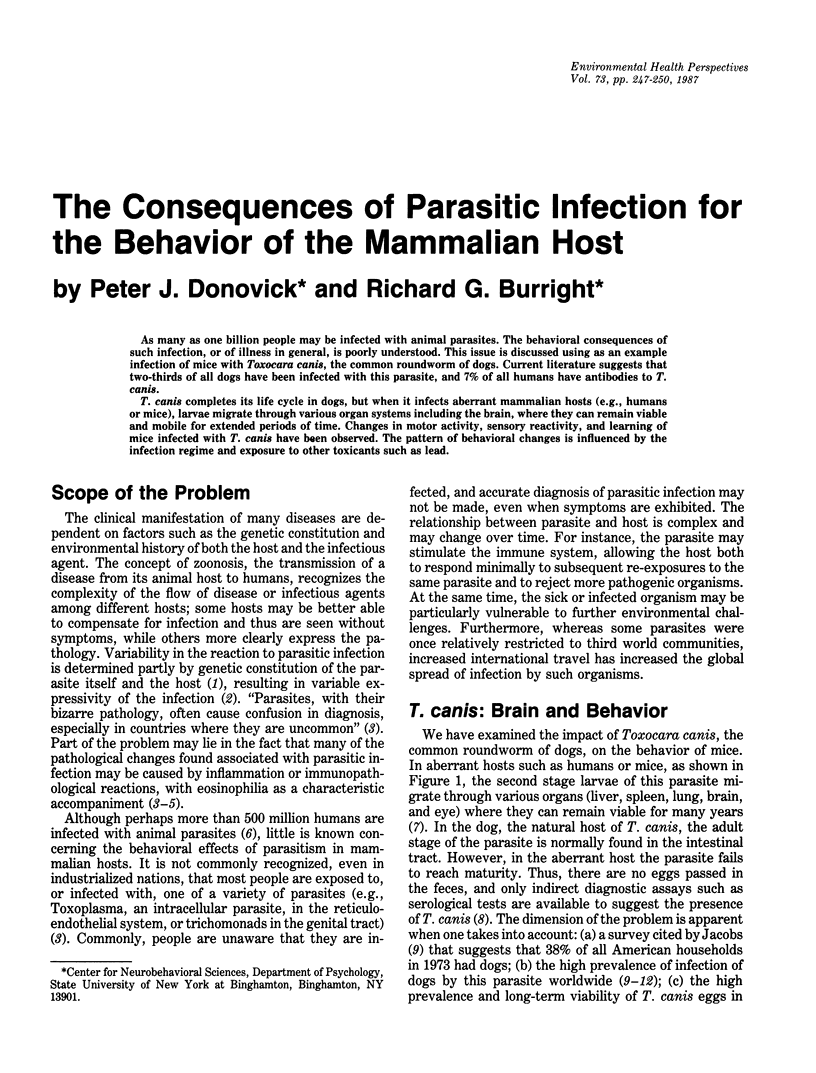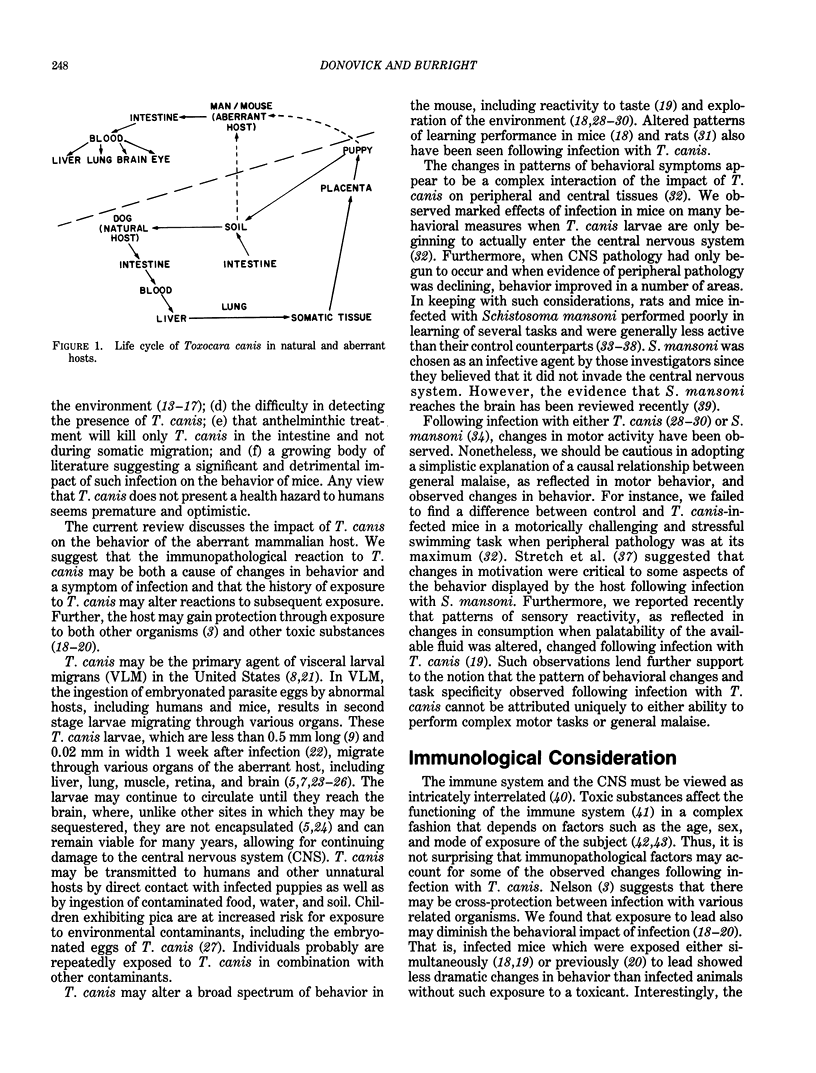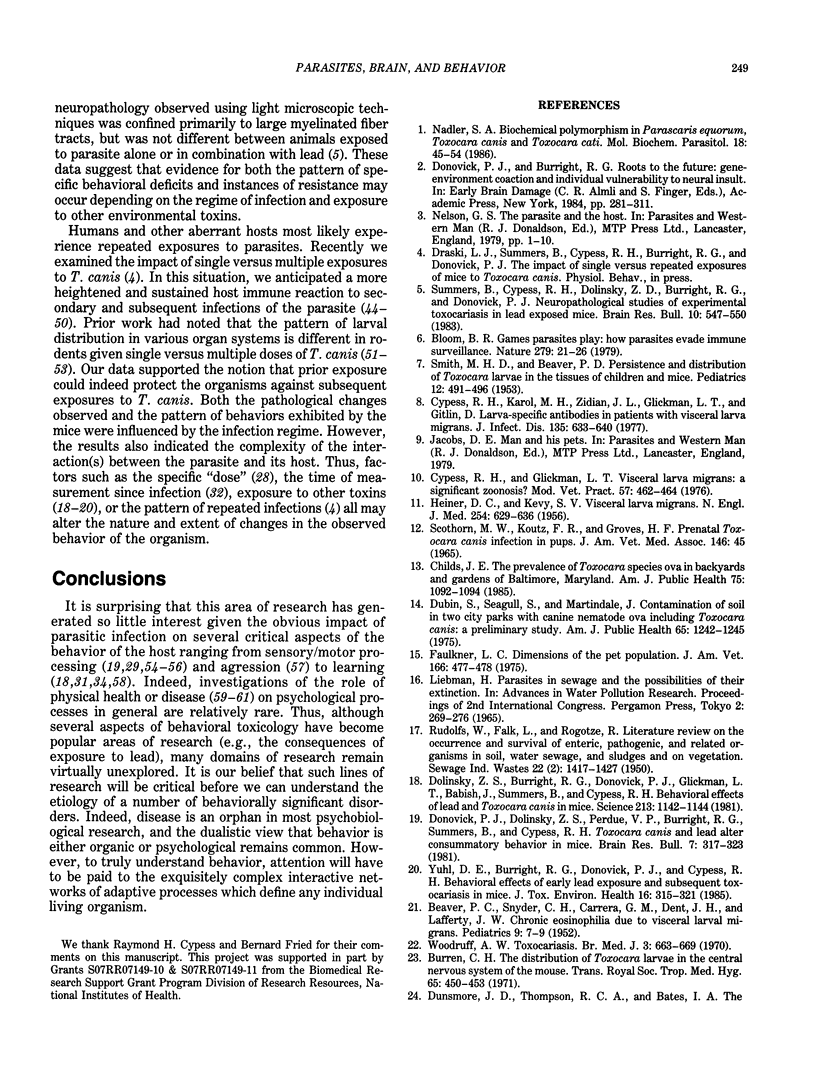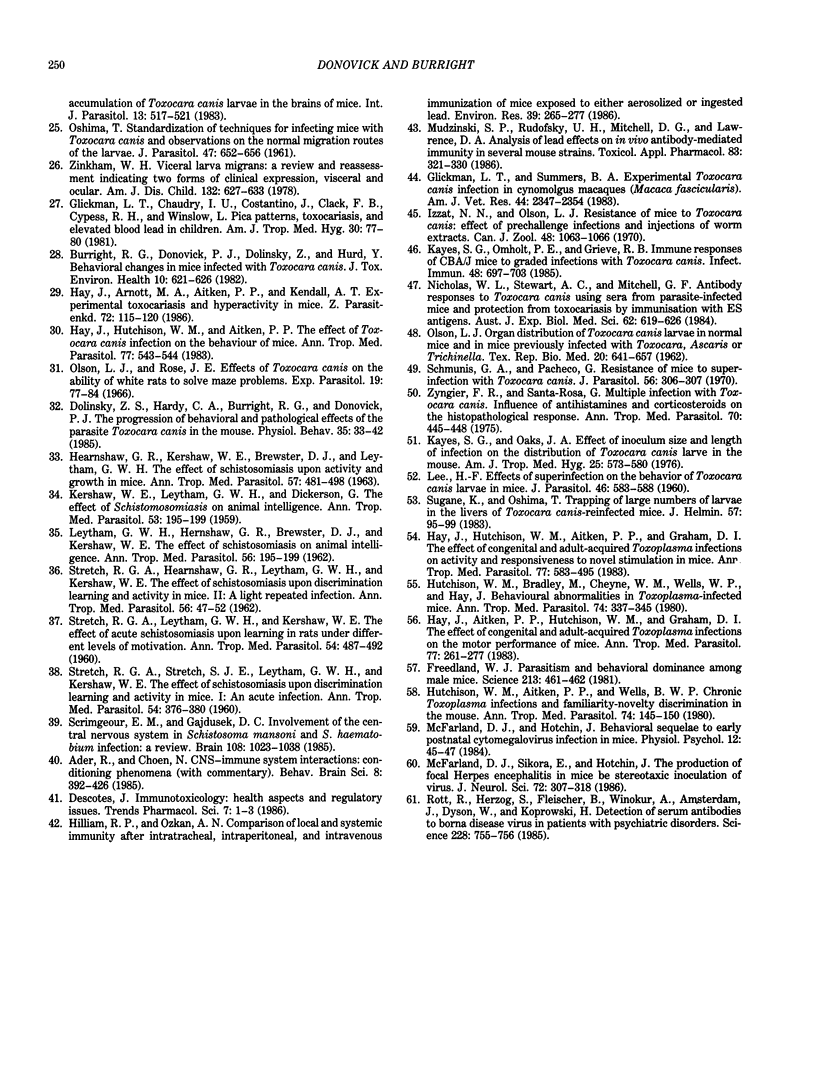Abstract
As many as one billion people may be infected with animal parasites. The behavioral consequences of such infection, or of illness in general, is poorly understood. This issue is discussed using as an example infection of mice with Toxocara canis, the common roundworm of dogs. Current literature suggests that two-thirds of all dogs have been infected with this parasite, and 7% of all humans have antibodies to T. canis. T. canis completes its life cycle in dogs, but when it infects aberrant mammalian hosts (e.g., humans or mice), larvae migrate through various organ systems including the brain, where they can remain viable and mobile for extended periods of time. Changes in motor activity, sensory reactivity, and learning of mice infected with T. canis have been observed. The pattern of behavioral changes is influenced by the infection regime and exposure to other toxicants such as lead.
Full text
PDF



Selected References
These references are in PubMed. This may not be the complete list of references from this article.
- BEAVER P. C., SNYDER C. H., CARRERA G. M., DENT J. H., LAFFERTY J. W. Chronic eosinophilia due to visceral larva migrans; report of three cases. Pediatrics. 1952 Jan;9(1):7–19. [PubMed] [Google Scholar]
- Bloom B. R. Games parasites play: how parasites evade immune surveillance. Nature. 1979 May 3;279(5708):21–26. doi: 10.1038/279021a0. [DOI] [PubMed] [Google Scholar]
- Burren C. H. The distribution of Toxocara larvae in the central nervous system of the mouse. Trans R Soc Trop Med Hyg. 1971;65(4):450–453. doi: 10.1016/0035-9203(71)90155-6. [DOI] [PubMed] [Google Scholar]
- Burright R. G., Donovick P. J., Dolinsky Z., Hurd Y., Cypess R. Behavioral changes in mice infected with Toxocara canis. J Toxicol Environ Health. 1982 Oct-Nov;10(4-5):621–626. doi: 10.1080/15287398209530281. [DOI] [PubMed] [Google Scholar]
- Childs J. E. The prevalence of Toxocara species ova in backyards and gardens of Baltimore, Maryland. Am J Public Health. 1985 Sep;75(9):1092–1094. doi: 10.2105/ajph.75.9.1092. [DOI] [PMC free article] [PubMed] [Google Scholar]
- Cypess R. H., Glickman L. T. Visceral larva migrans: a significant zoonosis? Mod Vet Pract. 1976 Jun;57(6):462–464. [PubMed] [Google Scholar]
- Cypess R. H., Karol M. H., Zidian J. L., Glickman L. T., Gitlin D. Larva-specific antibodies in patients with visceral larva migrans. J Infect Dis. 1977 Apr;135(4):633–640. doi: 10.1093/infdis/135.4.633. [DOI] [PubMed] [Google Scholar]
- Dolinsky Z. S., Burright R. G., Donovick P. J., Glickman L. T., Babish J., Summers B., Cypess R. H. Behavioral effects of lead and Toxocara canis in mice. Science. 1981 Sep 4;213(4512):1142–1144. doi: 10.1126/science.7268424. [DOI] [PubMed] [Google Scholar]
- Dolinsky Z. S., Hardy C. A., Burright R. G., Donovick P. J. The progression of behavioral and pathological effects of the parasite Toxocara canis in the mouse. Physiol Behav. 1985 Jul;35(1):33–42. doi: 10.1016/0031-9384(85)90168-4. [DOI] [PubMed] [Google Scholar]
- Donovick P. J., Dolinsky Z. S., Perdue V. P., Burright R. G., Summers B., Cypess R. H. Toxocara canis and lead alter consummatory behavior in mice. Brain Res Bull. 1981 Sep;7(3):317–323. doi: 10.1016/0361-9230(81)90022-8. [DOI] [PubMed] [Google Scholar]
- Dubin S., Segall S., Martindale J. Contamination of soil in two city parks with canine nematode ova including Toxocara canis: a preliminary study. Am J Public Health. 1975 Nov;65(11):1242–1245. doi: 10.2105/ajph.65.11.1242. [DOI] [PMC free article] [PubMed] [Google Scholar]
- Dunsmore J. D., Thompson R. C., Bates I. A. The accumulation of Toxocara canis larvae in the brains of mice. Int J Parasitol. 1983 Oct;13(5):517–521. doi: 10.1016/s0020-7519(83)80017-4. [DOI] [PubMed] [Google Scholar]
- Faulkner L. C. Dimensions of the pet population problem. J Am Vet Med Assoc. 1975 Mar 1;166(5):477–478. [PubMed] [Google Scholar]
- Freeland W. J. Parasitism and behavioral dominance among male mice. Science. 1981 Jul 24;213(4506):461–462. doi: 10.1126/science.7244643. [DOI] [PubMed] [Google Scholar]
- Glickman L. T., Chaudry I. U., Costantino J., Clack F. B., Cypess R. H., Winslow L. Pica patterns, toxocariasis, and elevated blood lead in children. Am J Trop Med Hyg. 1981 Jan;30(1):77–80. doi: 10.4269/ajtmh.1981.30.77. [DOI] [PubMed] [Google Scholar]
- Glickman L. T., Summers B. A. Experimental Toxocara canis infection in cynomolgus macaques (Macaca fascicularis). Am J Vet Res. 1983 Dec;44(12):2347–2354. [PubMed] [Google Scholar]
- HEARNSHAW G. R., KERSHAW W. E., BREWSTER D. J., LEYTHAM G. W. THE EFFECT OF SCHISTOSOMIASIS UPON ACTIVITY AND GROWTH IN MICE. Ann Trop Med Parasitol. 1963 Dec;57:481–498. doi: 10.1080/00034983.1963.11686203. [DOI] [PubMed] [Google Scholar]
- HEINER D. C., KEVY S. V. Visceral larva migrans; report of the syndrome in three siblings. N Engl J Med. 1956 Apr 5;254(14):629–636. doi: 10.1056/NEJM195604052541401. [DOI] [PubMed] [Google Scholar]
- Hay J., Aitken P. P., Hutchison W. M., Graham D. I. The effect of congenital and adult-acquired Toxoplasma infections on the motor performance of mice. Ann Trop Med Parasitol. 1983 Jun;77(3):261–277. doi: 10.1080/00034983.1983.11811707. [DOI] [PubMed] [Google Scholar]
- Hay J., Arnott M. A., Aitken P. P., Kendall A. T. Experimental toxocariasis and hyperactivity in mice. Z Parasitenkd. 1986;72(1):115–120. doi: 10.1007/BF00927742. [DOI] [PubMed] [Google Scholar]
- Hay J., Hutchison W. M., Aitken P. P., Graham D. I. The effect of congenital and adult-acquired Toxoplasma infections on activity and responsiveness to novel stimulation in mice. Ann Trop Med Parasitol. 1983 Oct;77(5):483–495. doi: 10.1080/00034983.1983.11811741. [DOI] [PubMed] [Google Scholar]
- Hay J., Hutchison W. M., Aitken P. P. The effect of Toxocara canis infection on the behaviour of mice. Ann Trop Med Parasitol. 1983 Oct;77(5):543–544. doi: 10.1080/00034983.1983.11811751. [DOI] [PubMed] [Google Scholar]
- Hillam R. P., Ozkan A. N. Comparison of local and systemic immunity after intratracheal, intraperitoneal, and intravenous immunization of mice exposed to either aerosolized or ingested lead. Environ Res. 1986 Apr;39(2):265–277. doi: 10.1016/s0013-9351(86)80053-6. [DOI] [PubMed] [Google Scholar]
- Hutchinson W. M., Bradley M., Cheyne W. M., Wells B. W., Hay J. Behavioural abnormalities in Toxoplasma-infected mice. Ann Trop Med Parasitol. 1980 Jun;74(3):337–345. doi: 10.1080/00034983.1980.11687350. [DOI] [PubMed] [Google Scholar]
- Hutchison W. M., Aitken P. P., Wells W. P. Chronic Toxoplasma infections and familiarity-novelty discrimination in the mouse. Ann Trop Med Parasitol. 1980 Apr;74(2):145–150. doi: 10.1080/00034983.1980.11687324. [DOI] [PubMed] [Google Scholar]
- Izzat N. N., Olson L. J. Resistance of mice to Toxocara canis: effect of prechallenge infections and injections of worm extracts. Can J Zool. 1970 Sep;48(5):1063–1066. doi: 10.1139/z70-188. [DOI] [PubMed] [Google Scholar]
- Kayes S. G., Oaks J. A. Effect of inoculum size and length of infection on the distribution of Toxocara canis larvae in the mouse. Am J Trop Med Hyg. 1976 Jul;25(4):573–580. doi: 10.4269/ajtmh.1976.25.573. [DOI] [PubMed] [Google Scholar]
- Kayes S. G., Omholt P. E., Grieve R. B. Immune responses of CBA/J mice to graded infections with Toxocara canis. Infect Immun. 1985 Jun;48(3):697–703. doi: 10.1128/iai.48.3.697-703.1985. [DOI] [PMC free article] [PubMed] [Google Scholar]
- LEYTHAM G. W., HEARNSHAW G. R., BREWSTER D. J., KERSHAW W. E. The effect of schistosomiasis upon activity in the albino rat. Ann Trop Med Parasitol. 1962 Jul;56:195–199. doi: 10.1080/00034983.1962.11686108. [DOI] [PubMed] [Google Scholar]
- McFarland D. J., Sikora E., Hotchin J. The production of focal herpes encephalitis in mice by stereotaxic inoculation of virus. Anatomical and behavioral effects. J Neurol Sci. 1986 Feb;72(2-3):307–318. doi: 10.1016/0022-510x(86)90018-3. [DOI] [PubMed] [Google Scholar]
- Mudzinski S. P., Rudofsky U. H., Mitchell D. G., Lawrence D. A. Analysis of lead effects on in vivo antibody-mediated immunity in several mouse strains. Toxicol Appl Pharmacol. 1986 Apr;83(2):321–330. doi: 10.1016/0041-008x(86)90309-1. [DOI] [PubMed] [Google Scholar]
- Nadler S. A. Biochemical polymorphism in Parascaris equorum, Toxocara canis and Toxocara cati. Mol Biochem Parasitol. 1986 Jan;18(1):45–54. doi: 10.1016/0166-6851(86)90049-6. [DOI] [PubMed] [Google Scholar]
- Nicholas W. L., Stewart A. C., Mitchell G. F. Antibody responses to Toxocara canis using sera from parasite-infected mice and protection from toxocariasis by immunisation with ES antigens. Aust J Exp Biol Med Sci. 1984 Oct;62(Pt 5):619–626. doi: 10.1038/icb.1984.59. [DOI] [PubMed] [Google Scholar]
- OLSON L. J. Organ disturbution of Toxocara canis larvae in normal mice and in mice previously infected with Toxocara, Ascaris or Trichinella. Tex Rep Biol Med. 1962;20:651–657. [PubMed] [Google Scholar]
- OSHIMA T. Standardization of techniques for infecting mice with Toxocara canis and observations on the normal migration routes of the larvae. J Parasitol. 1961 Aug;47:652–656. [PubMed] [Google Scholar]
- Olson L. J., Rose J. E. Effect of Toxocara canis infection on the ability of white rats to solve maze problems. Exp Parasitol. 1966 Aug;19(1):77–84. doi: 10.1016/0014-4894(66)90055-5. [DOI] [PubMed] [Google Scholar]
- Rott R., Herzog S., Fleischer B., Winokur A., Amsterdam J., Dyson W., Koprowski H. Detection of serum antibodies to Borna disease virus in patients with psychiatric disorders. Science. 1985 May 10;228(4700):755–756. doi: 10.1126/science.3922055. [DOI] [PubMed] [Google Scholar]
- SCOTHORN M. W., KOUTZ F. R., GROVES H. F. PRENATAL TOXOCARA CANIS INFECTION IN PUPS. J Am Vet Med Assoc. 1965 Jan 1;146:45–48. [PubMed] [Google Scholar]
- SMITH M. H., BEAVER P. C. Persistence and distribution of Toxocara larvae in the tissues of children and mice. Pediatrics. 1953 Nov;12(5):491–497. [PubMed] [Google Scholar]
- STRETCH R. G., HEARNSHAW G. R., LEYTHAM G. W., KERSHAW W. E. The effect of schistosomiasis upon discrimination learning and activity in mice. II. A light repeated infection. Ann Trop Med Parasitol. 1962 Apr;56:47–52. doi: 10.1080/00034983.1962.11686088. [DOI] [PubMed] [Google Scholar]
- Scrimgeour E. M., Gajdusek D. C. Involvement of the central nervous system in Schistosoma mansoni and S. haematobium infection. A review. Brain. 1985 Dec;108(Pt 4):1023–1038. doi: 10.1093/brain/108.4.1023. [DOI] [PubMed] [Google Scholar]
- Sugane K., Oshima T. Trapping of large numbers of larvae in the livers of Toxocara canis-reinfected mice. J Helminthol. 1983 Jun;57(2):95–99. doi: 10.1017/s0022149x00009342. [DOI] [PubMed] [Google Scholar]
- Summers B., Cypess R. H., Dolinsky Z. S., Burright R. G., Donovick P. J. Neuropathological studies of experimental toxocariasis in lead exposed mice. Brain Res Bull. 1983 Apr;10(4):547–550. doi: 10.1016/0361-9230(83)90153-3. [DOI] [PubMed] [Google Scholar]
- Woodruff A. W. Toxocariasis. Br Med J. 1970 Sep 19;3(5724):663–669. doi: 10.1136/bmj.3.5724.663. [DOI] [PMC free article] [PubMed] [Google Scholar]
- Yuhl D. E., Burright R. G., Donovick P. J., Cypess R. H. Behavioral effects of early lead exposure and subsequent toxocariasis in mice. J Toxicol Environ Health. 1985;16(2):315–321. doi: 10.1080/15287398509530743. [DOI] [PubMed] [Google Scholar]
- Zinkham W. H. Visceral larva migrans. A review and reassessment indicating two forms of clinical expression: visceral and ocular. Am J Dis Child. 1978 Jun;132(6):627–633. doi: 10.1001/archpedi.1978.02120310091020. [DOI] [PubMed] [Google Scholar]
- Zyngier F. R., Santa-Rosa G. Multiple infection with Toxocara canis. Influence of antihistamines and corticosteroids on the histopathological response. Ann Trop Med Parasitol. 1976 Dec;70(4):445–448. doi: 10.1080/00034983.1976.11687145. [DOI] [PubMed] [Google Scholar]


